In this article, we’ll walk you through the step-by-step process of building a successful money-making blog. From selecting a profitable niche and setting up your blog to creating high-quality content that resonates with your audience, driving traffic, and implementing various monetization strategies, we’ll cover it all.
Welcome to our comprehensive guide on how to make money blogging in 2023! Blogging has evolved from being a simple hobby to a lucrative profession that offers countless opportunities for individuals to earn a substantial income while sharing their passions and expertise with the world.
Whether you’re an aspiring blogger or already have a blog but want to monetize it effectively, this practical guide is here to help you navigate the ever-changing landscape of blogging and turn your passion into a profitable venture.
Additionally, we’ll share valuable insights and expert tips that are tailored specifically for the year 2023, ensuring that you stay ahead of the curve and maximize your earning potential.
How much money can bloggers earn?
The potential for blogging is virtually unlimited. Well-established bloggers like Ryan Robinson—who runs a blog about blogging—can make upward of $30,000 per month. Adam Enfroy, who started blogging about the business of blogging in 2019 as a side hustle, generated $1.5 million from his blog just two years later.
It’s not just monthly revenue that bloggers can cash in on. Marketplaces like Flippa list blogs for sale, many of which come with hefty six-figure price tags. Bloggers cash in when their creativity project is acquired.

Unfortunately, not every blogger can make millions through their website. The income potential of your blog depends on two factors:
- Your niche. Do people spend large sums of money on products in your industry? The software industry, for example, can be lucrative, since many companies pay recurring commission. Bloggers can earn small amounts each month, long after the customer made the purchase. (More on this later.)
- Your monetization strategies. Some blog monetization methods are off the table for new bloggers who want to stick to their core values—like not being paid to post content you don’t agree with. This can impact earning potential in the short term.
How long does it take to make money blogging?
Blogging is typically a side hustle people take up with the hopes that, one day, they’ll be able to quit their day jobs. Yet the length of time it takes to generate substantial income varies from blogger to blogger.
Some with an entrepreneurial mindset make their first $100 online within a few months—like Brittany Berger, founder of Work Brighter, who started earning money almost instantly. Berger created a simple, $20 digital download, which she promoted in her weekly newsletter and her newsletter signup page. “By starting that early on in the blog’s lifetime, I was able to convert a huge portion of the audience,” she says.
“I think waiting to launch something until you have a bigger audience can end up creating more pressure for yourself, so I’m glad I experimented with a small product when my audience was small.”
Mushfiq Sarkar is another blogger who started blogging on the side of his full-time job back in 2008. Though Mushfiq had no prior marketing experience, he says, “I left my job in April 2021 to focus on The Website Flip because it was growing significantly and I was more passionate about growing this website and blogging.”
Now, the blog makes significant revenue despite only being a few years old: “I launched at the peak of the pandemic in April 2020. A lot of people knew me by name, but not that I was an active blogger or someone who covered the industry. I started earning money fairly quickly—within a month or two.”
11 Ideas to make money blogging
Looking for a creative side hustle that will generate extra income? Whether you’re starting a new blog or growing an existing one, here are 11 ways to make money blogging.
1. Choose a profitable niche
A niche is a specific topic within a broad topic, such as vegan recipes. By choosing one for your blog, readers build an association with your site. They know exactly what they’ll get when visiting, improving your chances of being their first port of call when looking for advice.
“Before monetization, it’s all about quality and expertise if you want to stand out,” says Mushfiq, founder of The Website Flip. “First, figure out what your niche is and why you should be writing about that, and make a persona for yourself to be who you are in that topic. Once that happens, you’ll build a following over time. Monetization follows later.”

You’ll find bloggers making money in a wide variety of niches, from business software to pet accessories. Though not all niches are good ones.
A profitable blog niche meets three criteria:
- It’s something you’re skilled at and/or interested in. Blogs need a lot of consistently high-quality content to build an audience and become monetized. Not only will it be more enjoyable to blog about something you have a genuine interest in, but you’ll increase the likelihood of generating money. It’s easier to stick with a hobby we enjoy.
- Low in competition. Popular blogs, brands, or forums in your niche indicate others are making money in it. Similarly, do a Google search to assess keyword ranking difficulty. It’ll be harder to drive organic traffic if big-name brands (with even bigger marketing budgets) are dominating the first page of search results.
- Monetization potential. Look at monetization opportunities for each niche on your shortlist. Do companies in that niche pay to advertise their products on other blogs? Are there many affiliate programs that sell products in that industry? Both are telltale signs of a profitable blog niche.
2. Build an email list
To make money from your blog, you need loyal readers who value your recommendations.
One of the best ways to do this is by building an email list for your own blog. When someone opts in to hear from your blog, you’re given permission to reach readers in one place more sacred than all others: their inbox.
“Email marketing is by far the most lucrative sales channel for me. I don’t even really try to sell directly from other channels anymore, instead directing people from social media, collaborations, and SEO to my email list,” says Brittany Berger, founder of WorkBrighter
Encourage blog visitors to sign up to your mailing list using a pop-up box. The goal is to make anyone visiting for the first time opt into to hearing from you using an incentive, such as:
- Free checklists
- Lists of resources or recommended products
- Blog content packaged in a PDF (such as printable recipes)
Once they’ve signed up, continue nurturing that relationship with educational or entertaining content. You’ll build an audience ready to buy products off your recommendations.
Take it from Lily Ugbaja, who initially started her blog FindingBalance.Mom “because I wanted to stay home with my son, do something I love, and still make money.”
It took Lily two weeks to make money from the blog: “I used emails to promote my products and relevant affiliate products with tripwires and Facebook groups. You add lead magnets to your site so that people sign up after reading your article. Instead of a success page, you share a one-time offer—a low-end product at a super discounted rate, $7 in my case.
Despite the blog seeing less than 1,000 monthly page views, Lily says her first month ended with over $100 and, soon after, $100 became “a few thousand” each month.
“Think of your blog as a means to an end rather than the end itself,” says Lily. “Most successful bloggers monetize with products and affiliates and those streams don’t convert without serious planning. Build funnels, build backwards. Start with a product you want to sell then create blog content that supports the sales of that product.”
3. Write sponsored product reviews
All businesses want social proof to show their customers that their products are worth buying. One way for them to collect that is by paying bloggers to publish reviews.
Reach out to your favorite brands and ask if they’re interested in sponsoring a review on your blog. If you use the product outside of the purpose of the review, this tactic essentially costs nothing. You’re simply getting paid to share your opinion of a product you already own.
However, this monetization strategy gets a little murky. The Federal Trade Commission (FTC) recently fined Fashion Nova $4.2 million for suppressing negative reviews, even though—supposedly—a third-party service solicited them.
The FTC has a whole new set of guidelines that will affect ecommerce merchants and, ultimately, the bloggers they’re paying to write sponsored reviews.
Avoid landing your blog in hot water by:
- Disclosing whether you’re incentivized to write the review. If you’re being paid to publish a review, for example, include the following disclaimer in the introduction of your article: “I’ve been paid to write this review and may make a commission if you purchase this product.”
- Being honest. Share the good and the bad to help readers make an informed decision about whether they should purchase the item you’re reviewing.
4. Sell advertising placements
Companies are willing to pay bloggers for advertising placements on their websites. Lend them otherwise unused space in exchange for a fee.
There are two routes to building this income stream for your blog:
- Negotiate with companies individually. Find companies in your niche and ask if they’d be interested in advertising on your site. It’s the more time-consuming approach and you’ll need strong negotiating skills, but done well, it can net the most amount of money.
- Use an advertising network. Prefer the hands-off approach? Platforms like Google AdSense, Mediavine, and AdThrive claim space on your blog and handle the billing of advertisers. Simply embed their code on your site and get paid to show ads.
For Emily Brookes, a blogger at Emily May, display ads are the most lucrative sales channel for my blog. “Some 60% of my blog’s revenue comes from display ads,” she says. “Ads make me money consistently each month, even when I haven’t published any new content.”
To make advertising a substantial revenue stream for your blog, driving website traffic should be a priority.
Ad networks like Google AdSense pay per 1,000 impressions (CPM), with the average CPM for display ads falling around the $1.25 mark. The more people exposed to the adverts on your blog, the more money you’ll make.
Both Mediavine and AdThrive also require bloggers to meet minimum page-view requirements before applying to join the network. It’s an investment that’ll pay dividends in the long run. Monica Lent, founder of Not a Nomad Blog, generates the highest share of revenue through this type of blog advertising.

Afoma Umesi runs her book blog, Reading Middle Grade, on the side. “I had no experience and started blogging as a hobby before seriously deciding to monetize the site,” she says.
“I needed something passive, so I chose ads and affiliate links. I don’t want to make or sell digital products or services right now and I’m not a huge fan of sponsored posts, so ads were the perfect fit. All I need is traffic.
Reading Middle Grade currently earns between $800 and $1,000 per month—three-quarters of which comes from this type of advertising. Afoma says, “Don’t be afraid or ashamed to use ads. They’re inconvenient for some users, but if you provide value and use them reasonably, most users barely notice the ads.”
5. Join an affiliate marketing program
Affiliate marketing is the process of recommending products to your blog’s audience. You’ll receive commission when they purchase the product using your custom link.
It’s a great revenue opportunity for bloggers, since the content you share will already be influencing their purchase decisions. Make your blog a hub for educational content and you’ll build the know, like, and trust factors needed to make a sale.
The beauty of affiliate marketing is that you don’t need to create your own products. Plug into an existing ecommerce business and become a virtual salesperson for them. There’s no need to worry about producing marketing materials, shipping products, or dealing with customer service.
To make money blogging using this method, join an affiliate marketing network like ShareASale, AWIN, or ClickBank. Browse available programs in your industry, apply to join them, build custom links, and track affiliate revenue through the dashboard.
You can also search for high-ticket affiliate programs from merchants selling expensive products, such as electronics, jewelry, or software. Bloggers earn sizable checks when recommending those items to readers. Shopify affiliates, for example, earn 100% commission on the first two payments of any subscription plan.
6. Offer services
A natural byproduct of building your audience means more people associate your name with the blog topics you write about. That’s a great way to build authority—something people look for when hiring people to complete a service.
“If you’re in the B2B space like me, consulting is a big revenue generator. If you have some expertise and people are genuinely reading your content, what kind of consulting can you do for them? It’s a high revenue, low commitment way to make money blogging,” says Mushfiq, founder of The Website Flip
While running a service-based business is time consuming, it can be a quick way to make money online. Demand a higher hourly rate, and find high-paying clients, by using your blog content as a way to demonstrate your expertise.
Examples of services you can sell alongside your blog include:
- Consulting services
- Graphic design
- Freelance writing
- Virtual assistance
- Classes or workshops
Save time scheduling appointments and taking payments with apps like Acuity and Calendly. Promote your service through the blog—be that a standalone landing page or display ad in your sidebar—and start booking new clients.
7. Sell digital products
Digital products are a more scalable way to make money by selling things alongside your blog. Unlike service-based businesses, you don’t exchange time for money. And, unlike selling physical products, there’s no shipping or manufacturing costs.
You can create digital products once and sell an infinite number of them via your blog—hence the phrase “build once, sell twice.”
- “I decided to add printables—and soon other digital products—to diversify my income and put more control in my own hands. So far, I let readers decide how much they’d like to pay for my printables, which is why revenue numbers haven’t been crazy. However, I have clocked over 800 downloads, so I’m quite proud of that.” —Dylan Houlihan, founder of Swift Salary
Figure out what digital products your audience would buy using a reader survey with the question, “What problem do you need help with that the blog isn’t already solving for you?” Answers can unveil ideas you can package and sell as:
- ebooks
- Printables
- Workbooks
- Online courses
Benjamin Houy has been running the blog French Together full time for eight years. Part of the blog’s monetization strategy includes digital products—particularly the French course, which drives 90% of the blog’s revenue.
“Ads and affiliate links can be great monetization strategies depending on the niche, but creating a product is both easier and more profitable than most bloggers think,” Benjamin says. “Your product doesn’t have to be the absolute best product ever when you launch it, it just has to be something your audience will find genuinely useful and will be happy to pay for.
“Selling your own product is amazing because you get to improve it based on people’s feedback and you don’t have to worry about affiliate programs being discontinued or more and more people using ad blockers.”

8. Sell physical products
Does your blog have a cult following? Loyal readers of a blog quickly become raving fans, eager to support their favorite influencer. Help them do that—while also generating income for your blog—by selling physical products.
The print-on-demand model works well for small blogging businesses since you only pay manufacturing costs when a reader purchases a product. There’s no excess inventory, storage fees, or high upfront costs when bulk manufacturing products.
Use a service like Printful or Printify to create custom merchandise, such as:
- Mugs
- T-shirts
- Stickers
- Posters
- Tote bags
- Phone cases
Looking for inspiration? Her First $100K sells merchandise with messaging its target reader supports. You’ll see phrases the blog is known for, like “Smash the Patriarchy” and “Financial Feminist,” on branded tote bags and t-shirts.

Prefer something more hands-on? Start your first online store and treat your blog’s audience as your initial customer base.
One of the world’s most infamous beauty brands came to life thanks to the founder’s blog. Emily Weiss shared beauty tips on her blog, Into The Gloss, and built an audience of loyal fans. She later developed a skin care line that served the blog’s readership. That was the starting point for Glossier—a beauty brand now valued at over $1 billion.
Richard Belton is another entrepreneur who took this approach. He’s been blogging about maple syrup on his blog, Kaito Ridge, for almost eight years, using the site as a way to generate income through Amazon affiliate commission.
However, Richard recently switched his blog monetization strategy—and took control of the site’s income potential—by starting his first Shopify store. “I’m in the process of directing my articles, blog posts, and informational posts to link to my own Shopify store and reduce reliance on Amazon,” he says.
9. Create a membership community
Give your most engaged readers a VIP experience—one they have to pay a small fee in exchange for.
This type of community is an important part of social connection—something especially important in a world becoming increasingly online-first. Not only have communities shown to improve mental health, but 52% of shoppers will spend more on brands (or blogs) with shared values.

Take it from Michael Keenan, who runs a membership community alongside the Peak Freelance blog: “If you want a consistent revenue stream for your blogging efforts, create a membership program. You can offer exclusive content like handbooks and courses, special offers—even a Slack channel like the one we offer for Peak Freelance members.
“Set up your membership fees on a monthly or yearly basis. Provide a small discount for those who pay yearly. This gives you a nice cash injection you can use to develop new content and products for members.”
10. Monetize YouTube videos
Have you joined an affiliate program in an attempt to monetize your blog? Expand your reach—and subsequently, your income streams—by diversifying the content you create. Let’s dive into the different ways to make money on Youtube as an expansion of your blog content.
Add video marketing to your list to maximize affiliate commission. Some 88% of people have been convinced to buy something after watching a branded video. Make that your tutorial, review, or haul and you’ll get rewarded when a viewer purchases off the back of your recommendation.
Increase the dollars you earn through your blog by treating each piece of content like the foundation of a video script. Record yourself talking about the same topic, then edit the video and upload it to YouTube.
The bloggers behind A Beautiful Mess, for example, published a YouTube video that demonstrates how to create built-in shelves. The video description directs people to the blog write-up, which contains affiliate links to the products used in the tutorial.

This strategy works for several reasons. First, not everyone enjoys reading online content. Some people prefer to watch videos. You’re potentially alienating thousands of people by only producing written text.
Secondly, Google and YouTube are the two most popular search engines in the world. Sharing content to both platforms increases the likelihood of your target reader finding it—and therefore, purchasing products you’re an affiliate of.
For some queries, Google’s algorithm pulls YouTube videos in the search engine results page (SERP). The first thing you’ll see on the SERP for “how to groom your dog at home,” for example, is a YouTube video on the topic.

The best part? An active YouTube channel expands your revenue opportunities.
The platform comes with its own set of monetization features, including the YouTube Partner program, which is available to vloggers with more than 1,000 subscribers and 4,000 watch hours. Once enrolled, YouTube will display advertisements before your video loads. You’ll get paid every time a viewer watches it—a nice way to supplement your blog income.
11. Produce a podcast and get a sponsor
Speaking of alternative formats, podcasts are more popular than ever. More than half of US consumers have listened to a podcast—up from 33% in 2015.
But episodes don’t just fill time on morning commutes. Studies show that 53% of listeners will search online for more information after hearing about a product through podcast sponsorships. Another 35% will spark a conversation with a friend about the item in question. Both points make them attractive propositions for brands looking to expand their reach.
Capitalize on your audience’s attention by producing your own podcast. Record yourself talking about a topic in your niche and syndicate each episode to a streaming platform like Apple Podcasts or Spotify.
Reach out to brands in your niche with sponsorship opportunities. Sell ad space and give companies a shortcut to reach their target audience in exchange for a sponsorship fee.
This podcast revenue calculator shows a blogger with:
- 10,000 episode downloads
- Four new episodes each month
- Two adverts (one pre-roll)
…can add upward of $16,000 per year in revenue.
30 Proven Ways to Make Money Online Blogging with WordPress
Monetize Your Blog Content

When you think of how to make money blogging, advertising is often the first thing that comes to mind.
Yes, it is possible to make money with ads on WordPress, but there are also other ways you can monetize your blog content. Here are a few methods that work:
1. Make Money With Affiliate Marketing

Affiliate marketing is when you recommend a product or service to your audience using special tracking links, and then get a referral commission for every time someone buys after clicking your link.
A real-life example of affiliate marketing would be when you help a friend open a bank account at your bank branch. Usually, they give you a gift card or a bonus of some sort.
Similar to that many products and services online have affiliate programs that you can join. There are affiliate programs available for every industry (niche).
If you’re interested in getting started with affiliate marketing, you can start by thinking about the products you already use that your readers may be interested in as well. Then you can see if they have an affiliate program that you can sign up for.
You can find a huge list of products to promote from:
- Amazon
- Commission Junction
- ShareASale
Once you have selected the products to promote, then you can use a WordPress plugin like PrettyLinks to manage your affiliate links.
It allows you to quickly insert links into posts, create branded links, auto-replace keywords into links, and even see how each link is performing on your site.
Affiliate marketing is the easiest way to make money because you can promote a wide variety of products. Just about every popular store like Walmart, BestBuy, Amazon, and others have an affiliate program.
To learn more, see our beginner’s guide to affiliate marketing and also check out these affiliate marketing tools and plugins that will help you increase your earnings.
2. Display Google AdSense on WordPress

Google Adsense is an easy way to make money from your blog. All you need to do is add a script from Google to your website and start displaying ads.
You will get paid for every time a user clicks on the ad. These are called CPC ads.
What is CPC? CPC stands for “cost per click.” By displaying CPC ads with Google Adsense, you receive a set fee every time a visitor clicks on an ad.
The cost per click is set by the advertiser. (This is in contrast to CPM ads, where you’re paid for ad views instead of clicks. CPM means “cost per thousand impressions,” where M is the roman numeral for 1,000.)
Google Adsense is a good way to start earning money online when you are first starting out.
You can see our guide on how to monetize a WordPress blog with Google AdSense to get started, and this tutorial on how to optimize your AdSense revenue for more tips.
Looking for a Google AdSense alternative? Try Media.net. They also have a large pool of advertisers, and their payouts are good.
3. Use a WordPress Advertising Plugin to Sell Ads Directly
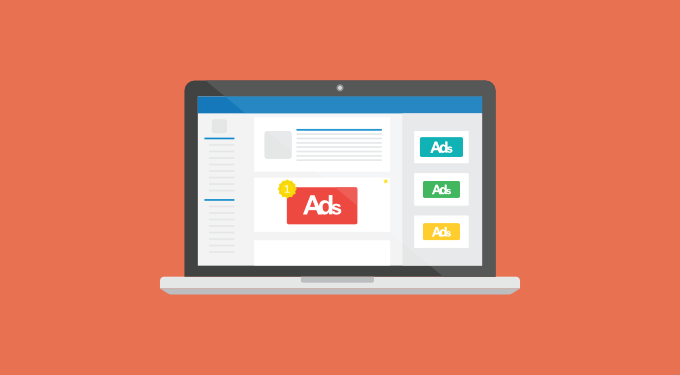
Google AdSense is easy to set up, but the amount of money you can earn is limited. Each ad click earning will vary.
Directly selling banner ad space on your website can be more lucrative. Instead of having to rely on an intermediary who takes a cut of the money, you negotiate the price and terms on your own.
Above we mentioned the difference between CPC and CPM ads, where you are paid per click or per thousand views. While you could use one of those models for selling banner ads, most bloggers charge a flat rate instead. Charging a flat rate is easier than keeping track of views or clicks.
Still, directly selling ads takes more work to manage than using Google AdSense. Instead of just adding a bit of code to your website, you’ll have to negotiate the pricing, come up with an agreement and terms, and take care of administrative work like invoicing.
However, using a WordPress ad management plugin can make the process easier. We recommend using AdSanity, it allows you to manage Google AdSense as well as your own ads.
To learn more, see our guide on how to sell ads on your WordPress blog.
4. Sell Sponsored Blog Posts
Some bloggers aren’t interested in displaying ads to their audience and wonder how to monetize a blog without ads.
With ad networks, you lose some control over the content displayed on your site. Some readers will get annoyed or offended by ads, and more and more people are using ad blockers which affects your earning potential.
An alternative way to monetize a blog is through sponsorships.

A sponsorship works just like it does in sports, TV shows, or other industries. Basically, a company pays you to represent their product, talk about it, and promote it to your readers.
To get started, it’s a good idea to put together a one-page media kit that details your traffic stats, social media following, audience demographics, and any other data that will make your site more appealing to advertisers. Then, you can approach companies to negotiate a sponsorship deal.
When publishing sponsored posts, it’s crucial to know about the laws in your area about disclosure.
For example, in the United States, a blogger who publishes a sponsored post must comply with the FTC’s Endorsement Guides. This includes disclosing whenever a post is sponsored. You can do that by adding a sponsored post prefix to your post title in WordPress.
5. Get Paid to Write Reviews

Similar to sponsored posts, you can also make money by writing paid reviews on your site.
This is a slightly different monetization method than a review site with affiliate links, as mentioned above.
Instead, you get to try out products related to your niche for free, and even get paid for writing a review.
The process for doing this can be similar to getting sponsored posts. You’ll want to review products that are relevant to your niche, that your audience would be interested in.
You can approach companies on your own to ask about doing paid reviews. There are also websites like PayPerPost that can help to connect you with businesses that may be interested.
6. Earn Money Online by Flipping Websites

If you know how to build a WordPress website, then you’re way ahead of most people. Sometimes entrepreneurs like to buy already established websites that they can use for their own businesses.
If you can build a WordPress blog and start getting traffic to it, then you can sell it and make money for your efforts.
This requires knowing the type of websites in demand, and how to price and sell them. There are websites like Flippa that serve as auction sites and brokers for selling websites.
7. Get Public Speaking Gigs as an Influencer

If you are promoting your own brand along with your blog, then over time you will get a decent following establishing you as an influencer in your space.
You can utilize this recognition to get some public speaking jobs. Many bloggers make a lot of money by speaking at conferences.
Speaking at events whether you are paid or not helps you promote your blog and your personal brand. If you are good at networking and public speaking, then you would be able to find lots of new opportunities on the way.
Here are some general tips you need to keep in mind if you want to make money as a paid public speaker.
- Be an expert in your field. If you don’t have enough knowledge/skills at the moment, then start learning right away.
- Be consistent – You need to continuously promote your expertise on the topic through your blogging and social media activities.
- Let people know that you are available. You can announce on social media or privately reach out to event organizers.
- You may not find paid public speaking gigs right away. Many successful speakers start their public speaking careers from smaller, more casual, and free community events and meetups.
Create a Paid Membership Website
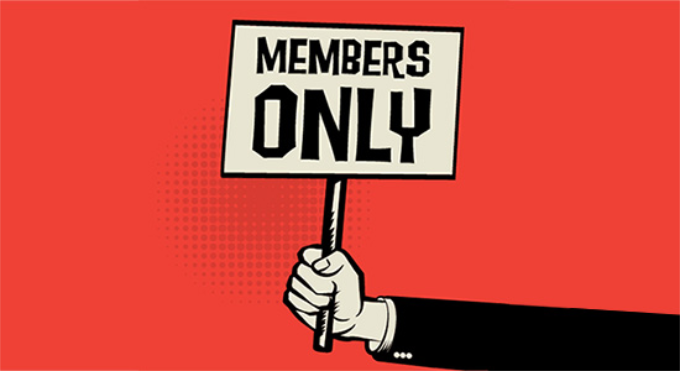
If you’re not interested in selling ads or sponsored posts, there are plenty of other ways you can earn money online from your blog. A popular method is by having your audience pay to access certain content or areas of your site. Here are a couple of ways to do that.
8. Create Restricted Members Only Content
Your most loyal readers are huge fans and may be willing to pay to read more of your work. You can create a members-only area for them to share more in-depth blog posts, downloads, videos, audio content, and more.
Membership sites can be a big-time investment since you must continually create premium content for your paying members. But they can be very lucrative because they are recurring revenue (subscriptions).
You can easily create a membership site using a WordPress membership plugin. We recommend using MemberPress, it is the most beginner-friendly and robust membership plugin for WordPress.
We have a complete guide on making a WordPress membership website with step-by-step instructions to help you get started.
9. Create a Private Forum
Another option for creating a paid membership site is to create private forums that users must pay to get access to. Forums are a great way for your audience to get one-on-one advice from you. Other members of the community can also interact and help each other out.
While moderating a forum can be a lot of work, a paid forum is a great way to earn recurring revenue from your WordPress site.
To get started, you’ll need to set up a forum on your site. Here are our recommended top 5 best forum plugins for WordPress.
10. Create a questions and answers community
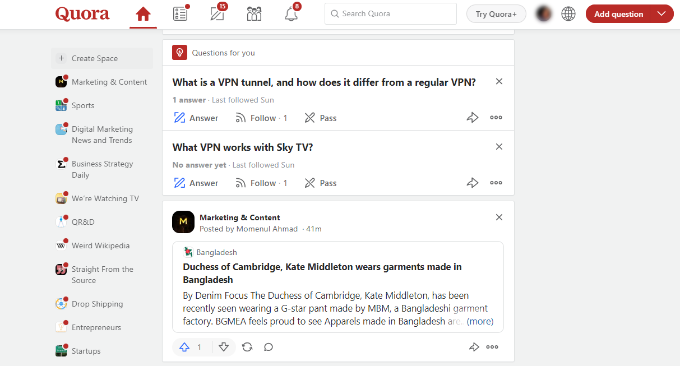
Question and answers communities like Stack Exchange and Quora are huge. They help you build an online community that is driven, motivated, and highly engaged.
Just like forums, you will have to spend some time building a sizable community. After that, you will be able to monetize user-generated content on your website using advertisements, affiliate ads, and other methods.
Popular question and answer websites are able to get direct advertisement and sponsorship deals from advertisers in their industry. This helps them negotiate a much higher rate and extra perks.
See our guide on how to start a Questions and Answers website using WordPress.
Create a Directory Website With WordPress

Another option for making money online with WordPress is to create a directory or listing website. You can then charge visitors to advertise their listings on your site.
Here are a few different directory ideas to get you started.
11. Create a Paid Business Directory
Web directories may make you think of the early days of the web before bots started indexing everything automatically, but they’re not completely obsolete. Some famous website directories include Yellow Pages, Yelp, and Angie’s List.
Generic web directories are no longer necessary, but local or niche directories can be extremely useful. For example, you can create a real estate directory for your local community.

Directories might gather reviews of local businesses, share the best podcasts on a given topic, or list the best products in a certain niche.
You can easily create a web directory in WordPress following our tutorial. There are also plenty of directory plugins for WordPress you can choose from, many of which allow you to accept payments with submissions.
12. Create a WordPress Job Board With Paid Submissions
Another option is to create a paid job board. Companies who want to advertise an open position to your audience can pay you to submit a listing.
It’s easier to create a successful job board if you narrow it down to a specific niche. That way you can become the go-to site for anyone looking for a job in that industry, with minimal competition.
This works great for established blogs in a narrow niche. For example, ProBlogger is now famous for its job board for professional bloggers.
With WordPress, creating a paid job board is easy. See our tutorial on how to create a job board in WordPress with WP Job Manager for a step-by-step walkthrough. You can use the WooCommerce Paid Listings addon to charge for job post submissions.
13. Create a WordPress Event Calendar With Paid Submissions
Instead of a job board, you could create an event calendar where you charge people to advertise their events. This also works well if you already have an established audience, because businesses will be willing to pay to reach your audience.

A paid event calendar is a good monetization method for local or industry-specific websites. You might choose to advertise events in your local city, conferences in a certain industry, or even webinars or live streaming events.
To set this up on your site, see our guide on the best WordPress event calendar plugins.
Sell Digital Products With WordPress

If you’re looking for a more low-maintenance way to make money online blogging with WordPress, then selling your own digital products may be a good choice. While you do have to invest the time to create the product up front, after it’s created your work is very minimal.
Here are a few digital products you can create and sell on your website.
14. Sell Ebooks on WordPress
Ebooks are an obvious choice for creating digital products. They are relatively simple to write and produce. If you’ve been blogging for a while, then you can collect some of your old blog posts and turn them into chapters of a book.
Once your book is written, you can design a cover using a tool like Canva and create a PDF of your ebook.
Selling digital products on WordPress is easy with a plugin. To get started, you can see our guide on the best WordPress eCommerce plugins compared.
For digital downloads, we recommend Easy Digital Downloads. It’s relatively easy to use and includes all the features you need to create your online store.
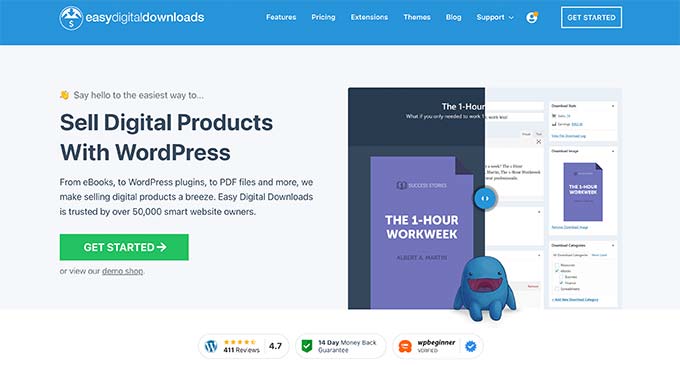
15. Sell Online Courses
Selling an online course is another great way to make money online.
Courses usually sell for a much higher price point than ebooks. You can charge a premium for your expertise.
You’ll need to create the lessons for your course, plus any supporting materials that you want to include such as downloads, slides, checklists, templates, etc.
You will also need to decide whether you want to offer personalized support for your course. Some sites offer two tiers of each course: a basic version without support, and a premium version with email support.
Once your course is ready, you can use a learning management system (LMS) plugin to deliver the course to your audience.
We recommend using MemberPress since they have a built-in course builder.
For detailed instructions, see our guide on how to sell online courses using MemberPress.
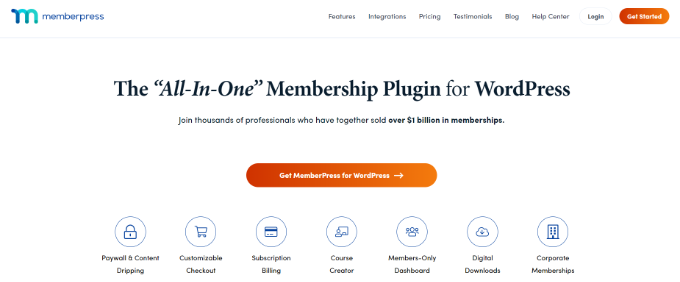
If you’re looking for a non-WordPress course builder, then see our article on the best online course platforms.
16. Host a Paid Webinar
Webinars are a great way to build your audience, share your experience, and grow your business. But did you know they’re also a smart way to make money online?
Webinars are similar to online courses, but a webinar is live and often includes a question and answer section.
WordPress makes it easy to host a paid webinar. Whether you’re using your site to actually host the webinar, or just to advertise your webinar and register participants, it’s crucial for your webinar’s success.
For more details on how you can host a paid webinar, see our list of the 9 best webinar software for WordPress users.
Sell Services Online Using WordPress

If you’re looking for easy ways to make money online, selling services is the fastest way to get started. There’s no up front investment in creating a product or investing in inventory.
Instead, you can just create a “hire me” page on your website and start looking for your first client.
Here are a few ideas to get you started.
17. Offer Freelance Services
As a blogger, you’re already an expert on your niche. You can start earning an income by offering your skills and expertise as a freelancer.
Freelancing is a popular way to make money online because it doesn’t necessarily require any upfront investment of time or money. You can just start offering your services to your current audience.
Once you start freelancing, you’ll need a way to invoice and collect payments from your clients. We recommend using either WP Simple Pay or FreshBooks, but there are also other invoicing plugins for WordPress.
If you’re interested in freelancing to make some serious money online, then see our list of the top tools for WordPress freelancers, designers, and developers for help getting started.
18. Start Your Own Consulting Business
Consulting is another way to make money online from your blog and share your expertise.
Instead of offering your services, a consultant offers advice and strategy so that their clients can become more effective.
As with freelancing, there is no startup investment. You can start offering consulting services on your existing blog. All you need is to create a page with a form so users can request more information.
To easily create a professional, mobile-friendly form, we recommend WPForms. You can see this tutorial on how to create a request a quote form in WordPress to get started.
19. Become a Coach
If “consultant” doesn’t feel like the right title for you, you can consider becoming a coach instead.
A life coach offers advice, guidance, and accountability for setting goals and improving one’s life. There are also other kinds of coaches, such as blog coaches, writing coaches, and more.
Whatever your area of expertise is, you can provide one-on-one help to your audience with coaching sessions.
To save time and make things convenient for your clients, you can set up a booking form so readers can schedule coaching sessions right from your WordPress blog.
Sell Physical Products Online Using WordPress
While selling digital products or services can be an easy way to start making money online, there’s nothing quite like selling real, physical products. Here are a few ways you can get started selling products with WordPress.
20. Start an Ecommerce Business With WooCommerce

Have an idea for your own product? Why not start your own online store?
WordPress makes it easy to create a shop or even add a shop to your existing blog using the free WooCommerce plugin.
Starting an online store can be a lot of work since you need to create or buy the products and then ship them out yourself.
But selling physical products can be a rewarding experience, and sometimes a physical product is exactly what your audience wants.
To get started, see our tutorial on how to start an online store with WooCommerce.
You can also use Shopify or BigCommerce as a WooCommerce alternative.
21. Create an Online T-shirt Store With WordPress
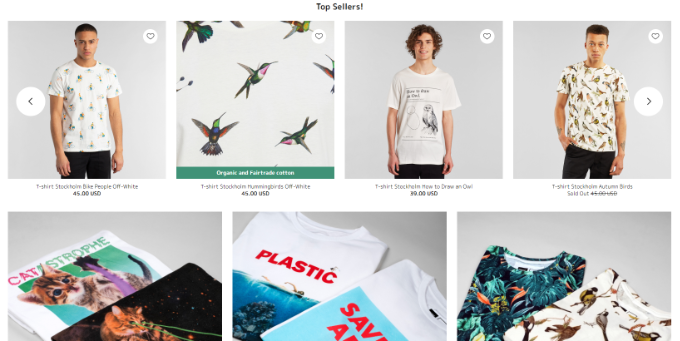
Creating your own t-shirt shop is easy with WordPress. Almost everyone wears t-shirts, so opening up a t-shirt shop is a great way to monetize any kind of blog. Designing t-shirts allows you to be creative and offer something unique to your audience.
It’s easy because there are services out there that allow you to upload your own designs, and they print/ship them for you. You get a profit share.
You can easily create your own t-shirt shop on your WordPress site using WP-Spreadplugin by Spreadshirt.
If you want a faster solution, then you can use a Shopify store that connects with dozens of t-shirt printing companies.
22. Create a WooCommerce Dropshipping Store
Dropshipping is another way you can create an eCommerce store on your WordPress website without having to handle inventory or ship items yourself.
With dropshipping, you create the store, manage the website, and customer service. But a dropshipping service will take your orders and ship them out to your customers. They’re an invisible third party that your customers don’t even know about.
You can use the WooCommerce plugin to create a dropshipping store. There’s also a WooCommerce Dropshipping addon plugin that allows you to automate the process.
23. Create an Amazon Affiliate WordPress Shop
One downside of dropshipping is that you have to find a good supplier, which can be a challenge, and sometimes you have to place a large order up front. This can make it difficult to get started without investing a lot of money.
If you want an easier way to set up an eCommerce site without having to ship products yourself, then you may want to try an Amazon Affiliate shop.
As with many of the items on this list, this works best if you specialize in a niche. If you offer everything, it’s impossible to compete with a big shop like Amazon. But in a small niche, you can differentiate yourself and really stand out.
For complete instructions, see our tutorial on how to create an Amazon affiliate store using WordPress.
Offering Platform as a Service
WordPress comes with some incredibly powerful plugins that are actually full-fledged platforms in their own right.
You can add such a platform to your blog or e-commerce store and offer it as a paid service. You get a cut from each sell, which allows you to earn passive income from user activity on your website.
24. Create an Online Marketplace Website
An online marketplace is like an eCommerce store where users cannot just buy but also sell their own products. Normally, WooCommerce assumes that you run a single-vendor website.
You will need a plugin like WC Vendors to turn WooCommerce into a multi-vendor capable platform. After that, vendors will be able to register on your site and start selling.
You can make money by charging a commission on each sale, or you can allow vendors to buy membership packages for their listings.
For more details, see our guide on how to make an online marketplace using WordPress.
25. Make an Auctions Website
An auctions website allows users to bid on products to purchase them. This allows the sellers to maximize their profits and customers to find unique deals.
eBay is probably the best example of an online auctions marketplace.
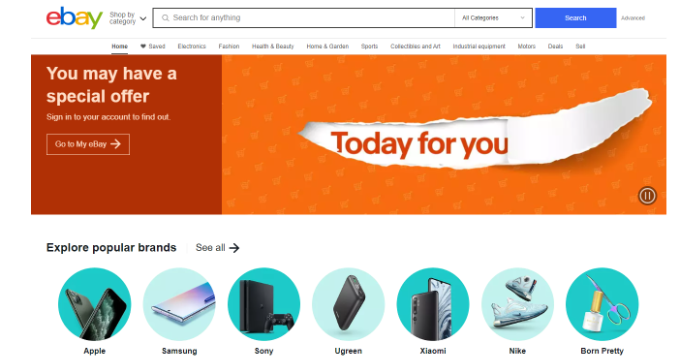
You can run auctions on your WordPress website and even allow third-party vendors to list their products as well. You can make money by charging for the listing or by getting a cut on each sale.
To build an auctions marketplace with WordPress, you will need the following add-ons.
- WooCommerce (for shopping cart and payment features).
- An auctions add-on
- A multi-vendor add-on
For step by step instructions, see our guide on how to build an eBay like auctions website using WordPress.
26. Create a Job Marketplace website
Unlike a regular job listings website, a job marketplace allows you to make money on each job listing. Fiverr and UpWork are probably the best examples of online job marketplace websites.
You can promote your job marketplace as a micro-job platform for people working in the same niche as your blog. To make your platform more competitive you can select a very specific niche.
This will help you easily find customers and professionals who are unable to use large platforms because of too much irrelevant competition.
You can charge a small fee for job listings or when a job is completed. More successful completion of jobs will bring you more customers and freelancers in the future.
For details, see our step by step tutorial on how to make a Fiverr like Micro-Job website using WordPress.
Become a WordPress Designer or Developer

If you’re more technically inclined, then you can become a WordPress developer or designer in order to make money online. This will take more technical skills, but it’s not too hard to get started.
27. Develop WordPress Plugins
Plugins are what make WordPress so flexible and powerful. Plugins work like apps, allowing you to extend and modify any feature of your WordPress website.
Plugins come in all varieties, from very simple code modifications to complex software applications. If you have a basic grasp of how WordPress works and some simple PHP knowledge, you can create your own WordPress plugin.
As a plugin developer, there are many ways you can distribute your plugins. Anyone can submit a free plugin to the WordPress.org plugin directory, as long as they follow the WordPress plugin guidelines. This is a great way to gain experience and build a reputation for yourself as a WordPress plugin developer.
Once you’re ready to start selling premium plugins, you could use your existing WordPress blog to sell them. You’ll want to make sure that the plugin you create directly fulfills a need of your audience before offering it for sale. You can create a survey to see what problems they need to solve on their WordPress site, and then create a plugin that solves that problem.
You can then sell the plugin on your site using Easy Digital Downloads.
28. Sell WordPress Themes
If you enjoy web design and development, you could start creating your own WordPress themes to sell.
This requires both design and technical skills. You have to know how to create a good-looking design, and also how to code it for WordPress.
Using a WordPress theme framework such as Genesis can give you a head start. Then you’ll need to design and code a beautiful child theme.
29. Sell Graphics on Your WordPress Site
If you like design more than coding, another option is to design and sell graphics on your WordPress site.
You can create graphics such as stock images or logos and sell them on your site using an eCommerce plugin. You can also join online marketplaces to sell your graphics as well.
30. Accept Donations

Last but not least, one way you can make money from your WordPress blog is simply to ask for it.
You can begin accepting donations in a few different ways. You could add a Paypal donate button or a Stripe donate button to your website. Or for a more professional look and advanced features like email marketing integration, you could use WPForms to create a donation form on your WordPress site.
Donations are last on the list because of their limited effectiveness, since you have to rely on the generosity of your readers. It’s usually more lucrative to offer them something in return.



